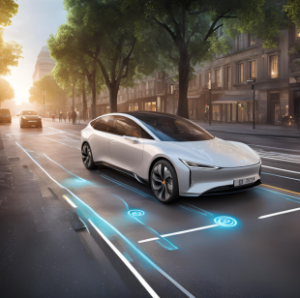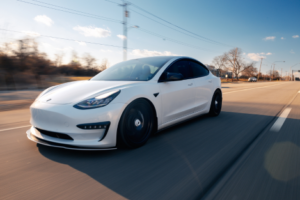Introduction
Augmented Reality (AR) is no longer confined to the realms of science fiction. It has quickly emerged as a transformative force across various industries, from healthcare and education to retail and entertainment. One of the most exciting areas where AR is making waves is the automotive industry. While AR is well-known for its role in gaming and mobile apps, its potential to revolutionize the way we interact with car interiors is something many are just beginning to grasp. By seamlessly integrating digital information into the physical world, AR is enhancing safety, comfort, and functionality in cars like never before.
In an era where innovation drives competition, automakers are leveraging AR technology to offer consumers a more intuitive, immersive, and safer driving experience. Whether it’s projecting crucial navigation information directly onto the windshield or providing entertainment and comfort features for passengers, AR is changing the way we think about the automobile. As autonomous vehicles and electric cars continue to dominate headlines, AR is playing a pivotal role in shaping the future of mobility. In this blog post, we will explore the current and future applications of AR in automotive interiors, discuss the benefits it brings to both drivers and passengers, and examine the challenges and opportunities that lie ahead.
What is Augmented Reality in the Context of Automobiles?
Before diving into the specific applications of AR in automotive interiors, it’s important to understand what AR actually is and how it functions in a vehicle setting.
At its core, Augmented Reality is a technology that overlays digital information—such as images, sounds, and other data—onto the real world. This is accomplished through the use of devices like smartphones, glasses, or, in the case of automobiles, integrated in-car systems. Unlike Virtual Reality (VR), which immerses the user in a fully digital world, AR works by blending virtual elements with the physical environment in real time.
In the automotive context, AR can take many forms. The most common application is the heads-up display (HUD), which projects important information like speed, navigation, and warnings directly onto the windshield or on a transparent screen in the driver’s line of sight. However, AR is much more than just navigation or speed displays. It extends to interactive entertainment systems, intelligent driver assistance technologies, and even autonomous vehicle interfaces.
As the automotive industry moves toward smarter and more connected cars, AR serves as the bridge between traditional in-car technology and the futuristic driving experience many manufacturers are aiming to create. By merging data from vehicle systems, cameras, and sensors with digital overlays, AR can make driving safer, more efficient, and more enjoyable.
Enhancing the Driving Experience with AR
One of the most significant ways AR is transforming car interiors is by elevating the driving experience itself. Traditional vehicle dashboards and control systems are giving way to more advanced, digital interfaces, many of which are powered by AR technology. Let’s take a look at how AR is enhancing the driving experience.
Heads-Up Displays (HUDs)
One of the most widely recognized applications of AR in vehicles is the Heads-Up Display (HUD). AR-enabled HUDs project critical data, such as speed, fuel levels, and turn-by-turn navigation instructions, directly onto the windshield. This allows drivers to access essential information without having to take their eyes off the road, reducing distractions and improving safety.
In addition to basic data, more advanced HUD systems can provide real-time hazard warnings, such as indicating the presence of pedestrians, animals, or other vehicles that may be in the driver’s path. The system can also provide visual cues to guide the driver through challenging driving conditions, such as fog, rain, or low-light situations.
Navigation Assistance
Augmented Reality is revolutionizing navigation in vehicles, providing a far more intuitive and user-friendly experience than traditional GPS systems. Instead of relying on a map displayed on a screen, AR technology overlays real-time navigation directions directly onto the driver’s view of the road.
For example, as the driver approaches an intersection, AR can display an arrow or pathway on the road, indicating the correct lane or turn to make. This visual guidance minimizes confusion, enhances confidence, and reduces the likelihood of drivers making wrong turns or missing exits. By integrating navigation with real-time road conditions, AR can further improve accuracy and efficiency in directing drivers.
Traffic Insights and Safety Enhancements
Beyond navigation, AR can also offer real-time insights about the surrounding traffic environment. By drawing on data from the car’s sensors and cameras, AR systems can highlight nearby vehicles, alert the driver to changing road conditions, and even identify potential hazards like construction zones, potholes, or icy patches.
More advanced AR systems can even predict potential collisions or help the driver navigate complex driving situations, such as merging onto a busy highway or changing lanes in heavy traffic. By providing visual feedback in real-time, AR enhances situational awareness, ultimately leading to safer driving practices.
Improving Passenger Comfort and Engagement with AR
While much of the focus on AR in automobiles has been on enhancing the driver’s experience, the technology is also making waves in improving the passenger experience. Car interiors are evolving from simple transportation spaces into personalized, immersive environments that cater to the needs and preferences of passengers.
Entertainment Systems
Long road trips or daily commutes can sometimes feel like a drag, but AR-based entertainment systems are changing that. Passengers can now enjoy interactive experiences, such as AR-based games, virtual tours, or educational content, all while on the road. Imagine a family taking a road trip, with the kids engaging in an AR-powered game that lets them interact with digital elements related to the passing scenery.
In addition to games, AR can be used to enhance the infotainment experience. For instance, passengers can view virtual reality-style 360-degree videos or experience immersive movies, all while seated in the vehicle. This not only makes the journey more enjoyable but also allows the vehicle to double as a mobile entertainment hub.
Personalized Interiors
AR technology is also playing a role in personalizing the interior ambiance of a vehicle. Today’s vehicles are equipped with a variety of systems that can adjust lighting, climate, and even seat positioning to suit the preferences of the driver and passengers. AR takes this a step further by allowing for more dynamic, real-time adjustments.
For example, AR systems can analyze the mood or preferences of the passengers and adjust the interior accordingly. If the passenger prefers a cooler temperature and a certain color scheme, the AR system can recognize these preferences and automatically adjust the vehicle’s environment to meet them. Similarly, AR can create ambient lighting effects that adapt to different times of day or driving conditions, such as providing soft lighting for nighttime drives or bright, energy-efficient lighting for day trips.
Interactive Window Displays
In addition to the traditional windows in a vehicle, AR-equipped windows can provide interactive overlays that enhance the passenger experience. These windows could display educational content about the passing scenery, offer interactive games for children, or even provide information about nearby landmarks. This turns the car’s windows into a dynamic information source, making them far more than just a way to see the outside world.
Safety Advancements Through AR
Safety is one of the most critical aspects of automotive design, and AR is playing an increasingly vital role in improving safety features. From enhancing driver assistance systems to reducing distractions, AR is reshaping how safety is integrated into car interiors.
Driver Assistance Systems (ADAS)
Advanced Driver Assistance Systems (ADAS) are already making cars smarter by helping drivers avoid accidents. AR takes these systems to the next level by providing real-time visual overlays that highlight potential dangers on the road. For example, AR can display an outline of a pedestrian crossing the street, allowing the driver to react faster. Similarly, the system can highlight vehicles in the car’s blind spot, reducing the risk of side-impact collisions.
Another key feature of AR in ADAS is its ability to project visual cues that assist with parking, lane-keeping, and automatic braking. For instance, when parking, AR can overlay helpful graphics, such as distance markers or obstacle warnings, to guide the driver into tight spaces.
Blind Spot Monitoring and Collision Avoidance
AR technology is also making a significant impact on blind spot monitoring and collision avoidance systems. Through real-time visual feedback, AR can display the surrounding environment on the dashboard or windshield, eliminating the traditional blind spots that many drivers experience. This provides a clearer view of the road and surrounding vehicles, ultimately improving safety.
Reducing Distractions
One of the most significant advantages of AR in the driving experience is its ability to reduce distractions. By consolidating vital information into a single, easy-to-read display, drivers no longer need to glance at multiple screens or controls. Everything they need, from navigation and vehicle status updates to road hazards and traffic information, is integrated into one streamlined AR interface. This reduces cognitive overload and allows drivers to focus on the task at hand—driving.
AR in Autonomous and Electric Vehicles
The advent of autonomous and electric vehicles (EVs) is another area where AR is proving invaluable. As self-driving technology continues to evolve, AR is playing a pivotal role in making these vehicles safer, more efficient, and more user-friendly.
Autonomous Driving and AR Feedback
Autonomous vehicles rely on a complex array of sensors, cameras, and software to navigate the road. However, for passengers to feel comfortable and trust these vehicles, they need to understand what’s happening inside the car’s systems. AR can provide visual feedback to passengers by overlaying information about the vehicle’s surroundings, such as what the car “sees” and how it’s making decisions.
For example, as the car approaches an intersection, AR might display a virtual view of the road, showing how the vehicle’s sensors detect other cars, pedestrians, and traffic signals. This not only builds trust in autonomous systems but also allows passengers to remain informed during the ride.
Electric Vehicle Monitoring with AR
For electric vehicles, AR interfaces can provide real-time data about the car’s battery status, charging points, and energy usage. This can help drivers plan routes, monitor energy consumption, and find the nearest charging stations with ease. By integrating this data




